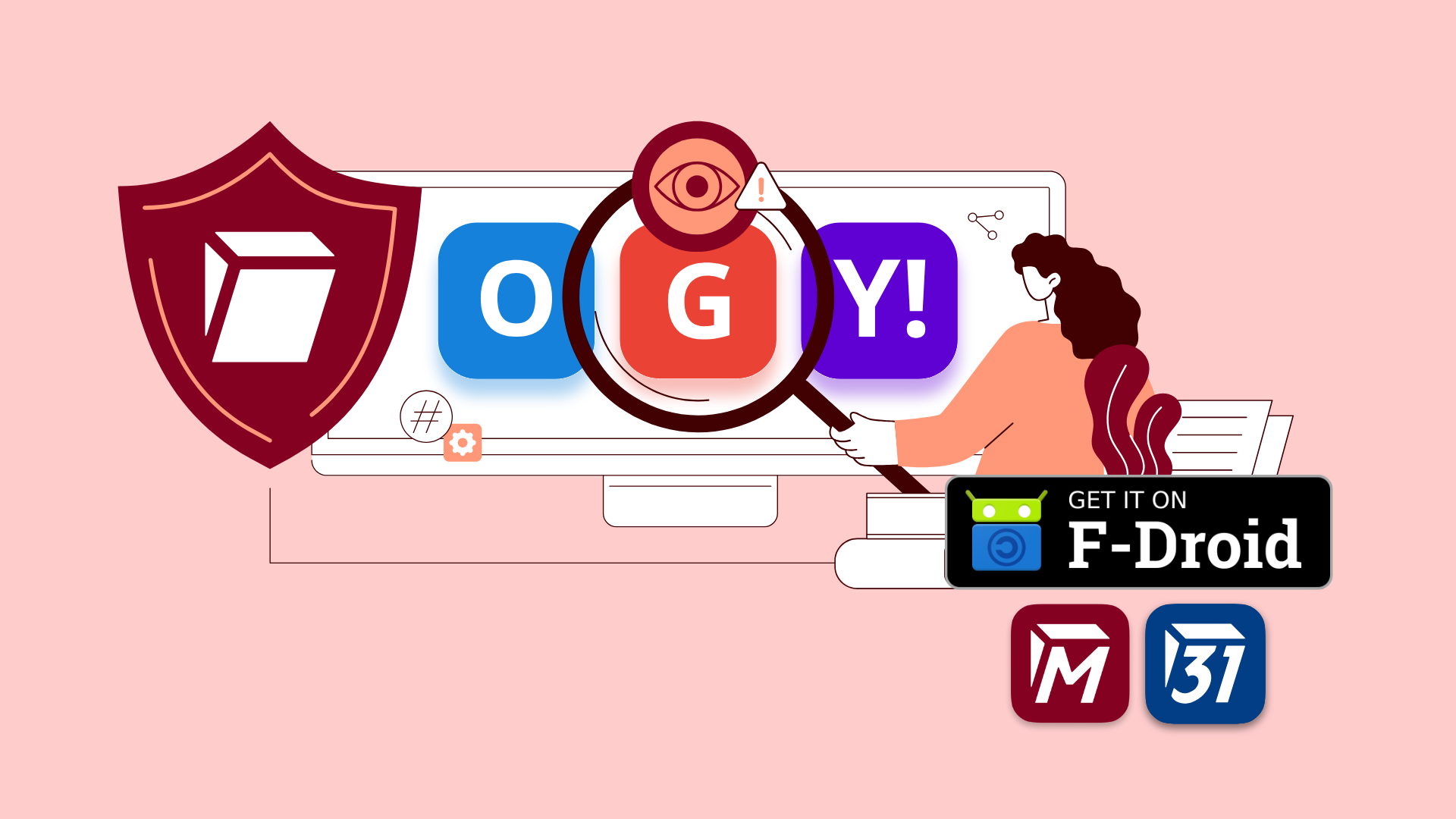Tuta Mail is available on F-Droid so you can break free from Big Tech tracking!
We're here to stop surveillance by corporations like Google and Apple. That's why we replaced Google's FCM with our own notification system and keep Apple Notification Data at a minimum. Learn here why this is important.
Enabling everyone to leave Google completely
Our aim with Tuta is to enable everyone to switch to a secure email service that respects your data and your right to privacy. It is very important to us that everyone can leave Gmail, also known as to “deGoogle”, completely.
For this reason, we enable you to download all our open source apps - Tuta Mail and Tuta Calendar - from our own website as well as from F-Droid, the open source Play Store alternative.
For being able to publish our email app on F-Droid, getting rid of Google’s push notification services was our top priority when rebuilding our secure mail app from scratch in 2017. We are very happy that we have managed to replace Google’s GCM for push so that the Tuta app has zero connection to Google. This protects you from Google’s massive data collection as well as warrantless government snooping.
Now new evidence shows that this preemptive shift was an important step in protecting your privacy. Tuta is the only encrypted email provider offering this level of privacy, not even the secure alternative Protonmail is taking this extra step.
Apple and Google Monitor All Your Push Notifications
Startling revelations were made by Reuters on December 7th, 2023, with evidence that governments around the world are spying on Apple and Google users by monitoring push notifications which are sent to their devices. This alternative form of surveillance was first brought to public attention after an open letter sent by US Senator Ron Wyden to the US Department of Justice was released.
These notifications allow intelligence and law enforcement agencies to link already collected metadata to Google or Apple accounts.
The Tuta Team was already aware of this potential risk years ago and in 2017, we replaced Google’s notification services with our own push notification service. If you are using Tuta on Android, no push notification data is shared with Google. Your privacy is safe with us.
We also support installing the Tuta app on Android devices through F-Droid which allows you to use the software without providing Google with the information that you are using it. But no matter whether you install the Android app via F-Droid or Google Play, your push notifications are safe with us and not susceptible to Google’s data collection and surveillance.
For maximum privacy protection, in the past all push notifications on iOS devices only display minimal information, merely informing you that a new email has been received. This way, we limit the potential data that could be collected by Apple and government surveillance attempts. When we added a notification preview to show sender and subject line in notifications, we made sure that this information is securely encrypted to protect you from surveillance by Apple! By now, you can even use quick actions on notificaitons from the Tuta app all while we are protecting your privacy to the maximum.
How we replaced GCM
GCM (or, how it’s called now, FCM, Firebase Cloud Messaging) is a service owned by Google. We at Tuta used to use FCM for our old Android app, up until 2017. Unfortunately, FCM includes Google’s tracking code for analytics, which we didn’t want to have in our secure email app.
And, even more importantly: For being able to use FCM, you have to send all your notification data to Google - which should be a no-go for any secure email service. You also have to use their proprietary libraries. Because of the privacy and security concerns that naturally go along with this, we did not send any information along with the notification messages with the old app (which, understandably, led to complaints from our users). Therefore, the push notification in the old Android app only mentioned that you received a new message without any reference to the email itself or to the mailbox the message has been placed in.
FCM is quite convenient to use, over the years Google made changes to Android which made it harder not to use their service for notifications. On the other hand, giving up Google’s notification service would free us from requiring our users to have Google Play Services on their phones. So that’s exactly what we did!
The challenge to replace Google’s FCM
The Tuta apps are Libre software, and we want to provide a true open source alternative to Gmail, which to us includes publishing our Android app on F-Droid. We wanted our users to be able to use Tuta on every ROM and every device, without the interference of a third-party service like Google.
We decided to take on the challenge and to build our own push notification service.
When we started designing our push system, we had several goals in mind:
- It must be secure
- It must be fast
- It must be power-efficient
We’ve made research on how other secure and private apps (Signal, Wire, Conversations, Riot, Mastodon) have been solving similar problems. We had several options in mind, including WebSockets, MQTT, Server Sent Events and HTTP/2 Server Push.
Replacing FCM with SSE
We settled on the SSE (Server Sent Events) because it seemed like a simple solution. By that I mean “easy to implement, easy to debug”. Debugging these types of things can be a major headache so one should not underestimate this factor. Another argument in favour of SSE was relative power efficiency: We didn’t need upstream messages and a constant connection to the server was not our goal.
So, what is SSE?
SSE is a web API which allows a server to send events to the connected clients. It is a relatively old API which is, in my opinion, underused. I’ve never heard about SSE before looking at the federated network Mastodon: They use SSE for real-time timeline updates, and it is working great.
The protocol itself is very simple and resembles good old polling: The client opens a connection, and the server keeps it open. The difference from classical polling is that we keep this connection open for multiple events. The server can send events and data messages; they are just separated by new lines. So the only thing the client needs to do is to open a connection with big timeout and read the stream in a loop.
SSE fits our needs better than WebSocket would (it is cheaper and converges faster, because it’s not duplex). We’ve seen multiple chat apps trying to use WebSocket for push notifications, and it didn’t seem power efficient.
We had some experience with WebSocket already, and we knew that firewalls don’t like keep-alive connections. To solve this, we used the same workaround for SSE as we did for WebSocket: We send “heartbeat” empty messages every few minutes. We made this interval adjustable from the server side and randomised to not overwhelm the server.
Multi-account support poses extra challenges
It should be noted that the Tuta app has multi-account support, and this posed a challenge for us: We wanted to keep only one connection open per device. After a few iterations, we’ve found the design that satisfied us. Each device has only one identifier. When opening the connection, the client sends the list of users for which it wants to receive notifications. The server validates this list against user records and filters out invalid ones.
Users may delete a notification token from their Settings but it would not affect other logins on this device. In addition to that, we had to build a delivery tracking mechanism when a notification is received. Unfortunately, we discovered that our server is unable to detect when a connection is broken so we had to send confirmations from the client side.
To receive notifications, we leverage Android capabilities. We run a background service which keeps the connection to the server open, similar to what the FCM process does. Another difficulty was caused by the Doze mode, introduced in Android M. The Doze, which is turned on after a period of inactivity, among other things prevents background processes to access the network. As you can imagine, this prevents our app from receiving notifications.
We mitigate this problem by asking users to make an exemption from battery optimizations for our app. It worked fairly well. The similar problem, but unrelated to Doze is vendor-specific battery optimizations. In order to prolong the battery life of their devices phone manufacturers, like Xiaomi, enable strict battery optimizations by default. Luckily users can disable them, but we must communicate this better.
Another problem was caused by the Android O changes. One of them is background process restrictions: Unless your app is visible to the user, your background processes are going to be stopped, and you’re unable to launch new ones.
Initially we thought that we can solve this by showing a persistent notification with minimal priority, which is visible in the notification gutter, but not in the status bar. This didn’t work for Oreo: If you try to launch a background service and use priority minimum for its notification, the notification priority is upgraded to a higher priority (visible all the time) and, in addition to that, the system shows another persistent notification: “App X is using battery”.
We initially planned to explain users how they can hide these persistent notifications but that wasn’t a great user experience, so we had to find a better solution. We leveraged Android Job mechanism to launch our service periodically (at least every 15 minutes), and we also try to keep it alive after-wards. We don’t hold WakeLocks manually – the system does this for us. We were able to ditch persistent notifications altogether. Even if notifications sometimes have a small delay, it will always be received and emails are there instantly.
In the end, we had to do some work, but it was totally worth it. We freed our users from Google Play Services requirement. Finally, everyone is able to get the Tuta app on F-Droid. The system now combines both: good power efficiency and speed.
The new Tuta Calendar app can also be found on F-Droid, our favorite app store.
Final thought: Every user should be able to choose a “Notification Provider” for every app
Wouldn’t it be great if the user could just pick a “push notifications provider” in the phone settings and OS managed all these hard details by itself? So every app, which doesn’t want to be policed by the platform owner, didn’t have to invent the system anew? It could be end-to-end encrypted between the app and the app server. There’s no real technical difficulty in that, but as long as our systems are controlled by big players who do not allow this, we have to solve it by ourselves.
For a free and open web, we need to stop giving all our private data to big corporations. That’s why we are saying: #NoMoreGoogle.


